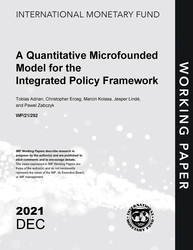
A Quantitative Microfounded Model for the Integrated Policy Framework
A Quantitative Microfounded Model for the Integrated Policy Framework
READ MORE...
Volume/Issue:
Volume 2021
Issue 292
Publication date: December 2021
ISBN: 9781616356538
$5.00
Add to Cart by clicking price of the language and format you'd like to purchase
Available Languages and Formats
| English |
Prices in red indicate formats that are not yet available but are forthcoming.
Topics covered in this book
This title contains information about the following subjects.
Click on a subject if you would like to see other titles with the same subjects.
Exports and Imports , Finance , Inflation , Economics- Macroeconomics , Economics / General , Monetary Policy , FX Intervention , Capital Controls , Sudden Stops , DSGE Model , capital flow management tool , FX intervention , monetary policy tradeoff , liquidity trap , policy rule , Sudden stops , Inflation , Currency markets , Exchange rates , Exchange rate devaluation , Global
Summary
We develop a microfounded New Keynesian model to analyze monetary policy and financial stability issues in open economies with financial fragilities and weakly anchored inflation expectations. We show that foreign exchange intervention (FXI) and capital flow management tools (CFMs) can improve monetary policy tradeoffs under some conditions, including by reducing the need for procyclical tightening in response to capital outflow pressures. Moreover, they can be used in a preemptive way to reduce the risk of a “sudden stop” through curbing a buildup in leverage. While these tools can materially improve welfare, mainly by dampening inefficient fluctuations in risk premia, our analysis also highlights potential limitations, including the possibility that their deployment may forestall needed adjustment in the external balance. Finally, our results also emphasize the power of FXIs to provide domestic stimulus in a liquidity trap.
Copyright © 2010 - 2025
Powered by:
AIDC



